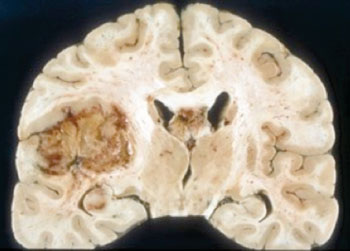Brain Tumor Chemotherapy Biomarkers Identified
By LabMedica International staff writers
Posted on 24 Jul 2014
Cancer researchers have identified a new biomarker that they believe can predict whether glioblastoma multiformes (GBMs), the most common and aggressive type of malignant brain tumor, will be susceptible to chemotherapy.Posted on 24 Jul 2014
Previous work had shown that the activity of the enzyme 6-methylguanine DNA methyltransferase (MGMT) was a critical determinant of how GBM cells would respond to the chemotherapeutic drug temozolomide (TMZ).

Image: Glioblastoma multiforme (GBM) (Photo courtesy of the University of California, San Diego School of Medicine).
The therapeutic benefit of TMZ depends on its ability to alkylate/methylate DNA, which most often occurs at the N-7 or O-6 positions of guanine residues. This methylation damages the DNA and triggers the death of tumor cells. However, some tumor cells are able to repair this type of DNA damage, and therefore diminish the therapeutic efficacy of TMZ, by expressing the protein O6-alkylguanine DNA alkyltransferase (AGT) encoded in humans by the O-6-methylguanine-DNA methyltransferase (MGMT) gene. In some tumors, epigenetic silencing of the MGMT gene prevents the synthesis of this enzyme, and as a consequence such tumors are more sensitive to killing by TMZ. Conversely, the presence of AGT protein in brain tumors predicts poor response to TMZ and these patients receive little benefit from chemotherapy with this drug.
Investigators at the University of California, San Diego School of Medicine (USA) had already found that MGMT was partially regulated by the microRNA (miRNA) miR-181d and other miRNAs. In the current study they sought to identify these other MGMT regulatory miRNAs and to determine whether any one in particular was the key regulator.
Towards this end, they performed a genome-wide screen to identify MGMT regulating miRNAs. Candidate miRNAs were further tested for inverse correlation with MGMT expression in clinical specimens.
The investigators identified 15 candidate miRNAs and characterized the top candidate, miR-603. They found that transfection of miR-603 suppressed MGMT mRNA/protein expression in vitro and in vivo; this effect was reversed by transfection with an antibody specific for miR-603. MiR-603 transfection enhanced the TMZ sensitivity of MGMT-expressing glioblastoma cell lines. Importantly, miR-603 mediated MGMT suppression and TMZ resistance were reversed by expression of an MGMT cDNA. In a collection of 74 clinical glioblastoma specimens, both miR-603 and miR-181d levels inversely correlated with MGMT expression. Moreover, a combined index of the two miRNAs better reflected MGMT expression than each individually.
“Every patient diagnosed with glioblastoma is treated with a chemotherapy called temozolomide. About 15% of these patients derive long-lasting benefit,” said senior author Dr. Clark C. Chen, professor of neurosurgery at the University of California, San Diego School of Medicine. “We need to identify which patients benefit from temozolomide and which another type of treatment. All therapies involve risk and the possibility of side-effects. Patients should not undergo therapies if there is no likelihood of benefit. We showed that a signature of the MGMT-regulating microRNAs predicted temozolomide response in a cohort of glioblastoma patients. Validation of these results should lead to diagnostic tools to enable us to determine which patients will benefit most from temozolomide therapy.”
The study was published in the June 30, 2014, issue of the journal Oncotarget.
Related Links:
University of California, San Diego School of Medicine




 assay.jpg)









